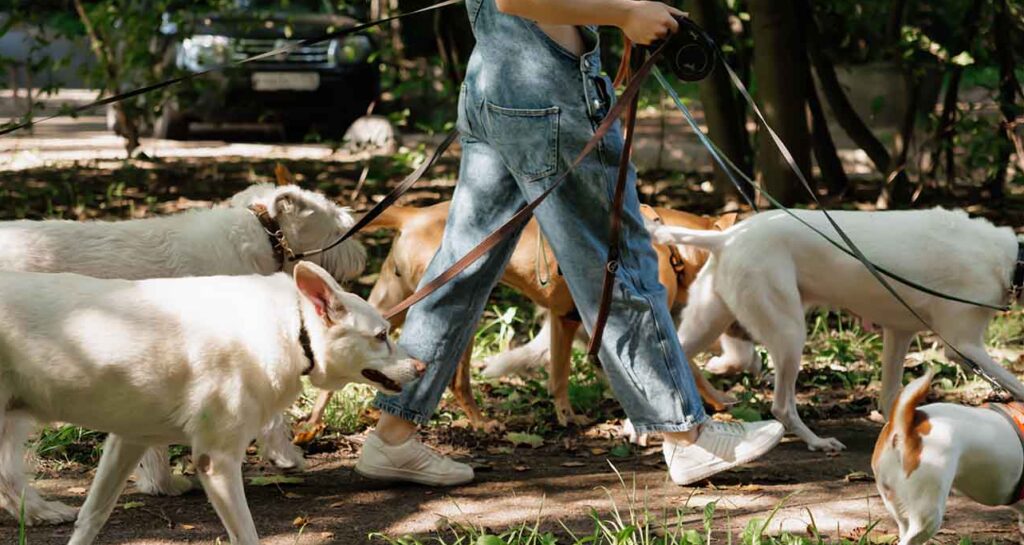Table of contents
Table of contents
The life of a tradesman is both rewarding and challenging, involving physical work, skill, and precision. But it’s no secret that the work also comes with unique risks and hazards that can pose serious dangers if not managed properly.
Whether you work as a sole trader or manage larger construction projects, taking responsibility for risks is going to be essential for a successful job.
This guide will walk through the most common risks faced by UK tradesmen, hidden hazards, practical steps to stay safe, and everything else you need to know about working safely in the trades.
Key risks and hazards faced by tradesmen

Tradespeople face a variety of hazards each day that demand constant awareness and caution. Here’s a look at some of the biggest ones:
Falls from heights
Falls remain a leading cause of injury on worksites, especially for those working on scaffolding, ladders, and roofs. It’s crucial to secure ladders, use guardrails, and always be aware of the distance from the ground.
Electrical hazards
Electricians, plumbers, and general contractors face electrical risks when working around live wires, faulty wiring, and unmarked cables. Checking for power sources, using insulated tools, and wearing appropriate protective gear is essential.
Hazardous materials exposure
From asbestos to silica dust, tradesmen often work around materials that can cause long-term health issues if inhaled or touched. Proper handling, PPE, and following safety guidelines are necessary to avoid exposure.
Heavy machinery and tools
Power tools, saws, and heavy machinery are part of the job, but they carry serious risks of cuts, fractures, and other injuries. Regular training on safe handling and maintenance is crucial.
Confined spaces
Working in cramped spaces can limit movement and ventilation, leading to risks like oxygen deficiency and even entrapment. Trades like plumbing, HVAC, and electrical work often involve confined spaces, so training and supervision are key.
Repetitive motion and musculoskeletal disorders
Jobs requiring repetitive movements, like painting, tiling, and carpentry, can lead to strain and musculoskeletal disorders over time. Regular breaks and proper lifting techniques can help reduce strain injuries.
Contractor risks: protecting property, plant, and tools

While personal safety is paramount, tradesmen must also consider the risks to the property they’re working on, as well as the tools, equipment, and plant machinery they rely on. Here are some of the common contractor risks and how to mitigate them:
Damage to client property
Whether it’s accidental damage to walls, flooring, or fixtures, even small mishaps can be costly and impact client relationships. Maintaining a clean and organised work area, using protective coverings, and taking care during movements can help reduce these risks. Liability insurance can also protect against potential claims for accidental property damage.
Plant and equipment theft
With high-value tools and machinery left on-site, theft is a serious risk, particularly on unsecured construction sites. Keeping an inventory of tools, using secure storage containers, and investing in anti-theft measures like tracking devices can deter theft. Ensuring tools and equipment are covered by insurance is also critical, why is why we offer tradesman’s tool insurance.
Equipment damage
Heavy machinery and specialist equipment can be easily damaged if not handled or stored properly. Conduct regular maintenance checks, follow manufacturer guidelines, and avoid lending tools to untrained staff. For plant machinery, ensuring only qualified operators are on hand can help prevent costly repairs and times it’s not operational.
Fire and environmental hazards
Working with flammable materials or near electrical sources poses fire risks, and materials like paints, solvents, or chemicals can lead to environmental hazards. Proper storage, regular inspection of hazardous materials, and having fire extinguishers on-site are essential safety steps.
Accidental utility damage
Inadvertent damage to water pipes, gas lines, or electrical conduits is common, especially during renovations or excavations. Reviewing site plans before starting work, conducting thorough checks for utility locations, and working with experienced contractors can help avoid these costly incidents.
Business risks: managing financial and operational risks
Running a trade business isn’t just about doing quality work – it also means managing business risks that can impact your financial stability and reputation. Here’s a look at some of the key business risks tradesmen face:
Financial loss from uninsured damages or liabilities
Unforeseen events like property damage, injury, or theft can be financially devastating without the right insurance. Public liability insurance, professional indemnity, and tool insurance can help protect against major financial losses that could harm the business.
Cash flow challenges
Tradesmen often face cash flow challenges due to delayed payments, unexpected expenses, or seasonal downturns. Implementing clear invoicing procedures, setting up deposits, and managing expenses can help stabilise cash flow. Considering business financing options or lines of credit can provide a buffer during lean periods.
Project delays and contract penalties
Delays due to weather, supply chain issues, or unexpected repairs can lead to missed deadlines, affecting cash flow and client satisfaction. Keeping realistic project timelines, communicating proactively with clients, and working with reliable suppliers are essential strategies. Additionally, understanding contract terms and potential penalties is crucial to avoid costly misunderstandings.
Reputation and client relationships
Reputation is everything in the trades, where word-of-mouth and online reviews can make or break a business. Miscommunications, missed deadlines, or quality issues can harm your standing. Maintaining strong communication, following up with clients, and addressing complaints quickly and professionally can help protect your reputation.
Regulatory compliance and legal risks
Not adhering to health and safety standards, employment regulations, or industry guidelines can lead to legal trouble and hefty fines. Keeping up-to-date with relevant regulations, maintaining proper documentation, and conducting regular compliance audits can help avoid legal headaches.
Cybersecurity risks
As more tradesmen manage client communications, invoices, and schedules online, cybersecurity has become a real concern. Phishing attacks, data breaches, and fraud are increasingly targeting small businesses. Using secure payment systems, implementing password protections, and staying vigilant against phishing can reduce your exposure to cyber threats.
Steps to reduce risks and promote safety

Minimising risks on the job isn’t just about compliance – it’s about ensuring everyone gets home safely at the end of the day. Here are some practical steps to stay safe:
Use of personal protective equipment (PPE)
Proper PPE, including hard hats, gloves, high-visibility vests, ear protection, and dust masks, is essential for safety. PPE may vary depending on the job, but it should always be in good condition and fit properly.
Training and certifications
Regular training on equipment uses and hazardous materials is vital. It’s also a good idea to keep up-to-date with certifications, especially for operating heavy machinery and handling dangerous substances.
Regular equipment checks and maintenance
Regular checks ensure that tools and machinery are safe to use. Malfunctioning equipment can lead to serious accidents, so keeping everything in working order is crucial.
Hazard awareness and site preparation
A safe workspace starts with a tidy site. Keeping walkways clear, marking off hazards, and setting up a safe workspace can prevent many accidents.
Health monitoring and ergonomic practices
Regular health checks can identify early signs of strain or illness, and practicing good ergonomics – like lifting with the legs and not the back – can prevent injuries.
Mental health resources
Staying mentally healthy is just as important as physical safety. Access to mental health support, a good work-life balance, and a supportive team can make a big difference.
Common workplace accidents among tradesmen
Understanding the most common types of accidents can help tradesmen know where to focus safety efforts:
Falls from ladders or scaffolding
Make sure ladders and scaffolding are secure, placed on level ground, and that safety measures are in place.
Cuts and lacerations
Injuries from tools and machinery are common. Always use tools as intended, wear gloves when needed, and keep tools sharp to reduce risk.
Electrical shocks and burns
De-energise circuits when working around electricity, use insulated tools, and check for exposed wires to avoid electrical accidents.
Material handling injuries
Lifting heavy objects is common, but back injuries are avoidable with good lifting practices. Ask for help with heavy loads or use equipment like dollies when available.
Burns and chemical exposure
From hot surfaces to harmful chemicals, burns and exposure injuries are common but avoidable. PPE and proper training in chemical handling are essential.
Legal requirements and UK regulations
Understanding the legal landscape can help tradesmen stay compliant and avoid penalties:
Health and Safety at Work Act (1974)
This act outlines the responsibilities of both employers and employees to ensure safe working conditions. Employees have the right to a safe environment and should report hazards promptly.
Construction (Design and Management) Regulations (CDM 2015)
These regulations govern the planning and management of safety on construction sites, emphasising risk prevention from project start to finish.
HSE guidelines and inspections
Following the Health and Safety Executive’s (HSE) recommendations can help tradesmen and businesses stay compliant with UK law and avoid accidents.
FAQs on safety, risks, and hazards for tradesman
What PPE is mandatory for tradesmen in the UK?
PPE requirements vary, but common items include hard hats, gloves, high-visibility clothing, and hearing and respiratory protection, depending on the nature of the job.
How can I minimise long-term health risks as a tradesman?
Regular health checks, wearing proper PPE, practicing good posture, and taking breaks all help to prevent long-term injuries and illnesses.
How can I report unsafe conditions on my job site?
Report unsafe conditions to your supervisor or manager. If necessary, you can also report to the HSE, which allows for anonymous reports of dangerous work environments.
Are there mental health resources available for tradesmen?
Yes, many organisations provide support for mental health in the trades. Talking to a supervisor or seeking professional help can make a big difference.
Working safely as a tradesman takes awareness, preparation, and ongoing education. By following recommended practices, staying up-to-date on legal requirements, and taking care of both physical and mental health, tradesmen can help create a safer workplace for everyone involved.
Remember: safety isn’t just about compliance – it’s about making sure you, and those around you, get home safely each day.
Get Tradesman Insurance from Protectivity
*Disclaimer – This blog has been created as general information and should not be taken as advice. Make sure you have the correct level of insurance for your requirements and always review policy documentation. Information is factually accurate at the time of publishing but may have become out of date.
Last updated by


















